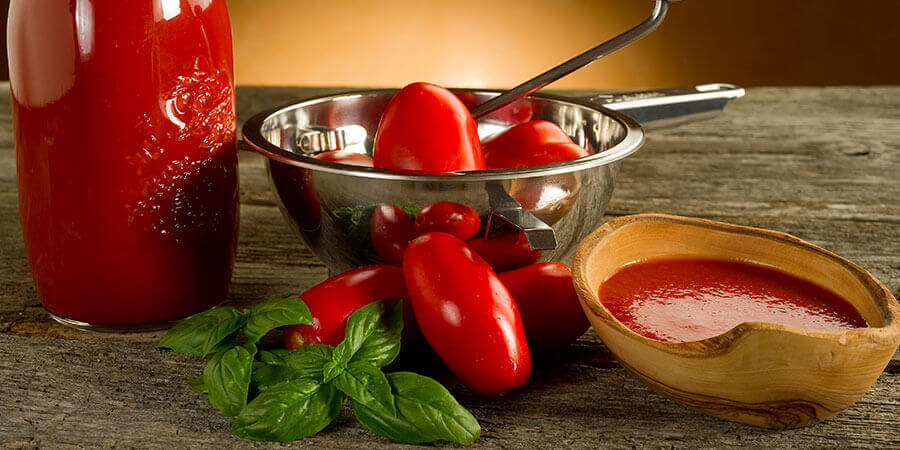Food Mill vs Food Processor: What Are the Differences?

You’ve likely heard of both food mills and food processors before, but what are they, and how do they compare and contrast? That’s what we here at GoFoodservice aim to help you discover in this guide to the difference between food processors and food mills.
In reading through our introduction to food processors and mills, we hope you can develop an appreciation for both devices and their unique uses in the kitchen. Ready to get started? Let's learn about the differences between food mills and processors!
What is a Food Mill?
Food mills are either electric or manually-operated machines that both mash and sieve food through a series of perforated plates. They excel at making mashes and purees efficiently and quickly.
What’s more, as we mentioned in our Food Mill Buying Guide, “Plates are interchangeable and allow for varying thicknesses of the end product. This ultimately separates the solid parts of the fruit and vegetables (like the seeds and skin) and collects all of the more desirable parts like the bulk of a potato or fruit juices.”
Further, “A food mill may sound very similar to a strainer or sieve but their end result is quite different. Sieves only give you the bare minimum of juice, and the fruit or vegetable must first be broken down to collect it. On the other hand, food mills bring all the muscle and do the breaking down for you. Food mills are great for things like mashed potatoes and thick tomato juices whereas a sieve is good for draining pasta or creating a pulp.”
What is a Food Processor?

Food processors are electric kitchen appliances that vary in size from 1 quart to 3 quarts (for home use). Commercial food processors, on the other hand, can be up to 50 or 60 quarts. Regardless of size, all food processors share the same function: using a sharp rotating blade like a blender to break food down into smaller pieces.
Food processors can be used to puree foods like a food mill, but they are also just as often used for chopping, mincing, blending, and even kneading.
Oftentimes, food processors even come with interchangeable attachment plates that also allow for grating and shredding. For instance, as opposed to making hash browns by grating potatoes on a box grater, you could use a grating attachment on a food processor to make the process much faster and more efficient.
Are There Different Types of Food Processors?
Technically, a food processor is anything that breaks down food into smaller pieces, so that could include graters, mixers, or even blenders. There are also manual food processors out there, though when most people refer to a “food processor” they’re referring to an electrically-operated device that has a donut-shaped plastic or glass “bucket” into which food goes.
A blade is usually fitted over the middle portion of the unit (think of it sitting on top of the “donut hole”). This construction allows for food to easily spin around and get processed without the same loss of suction that a blender often results in.
Which Type of Food Processor is Best?
For commercial kitchens, it should come as no surprise that a commercial processor will work best due to its larger size compared to home units. For instance, in making restaurant-style salsa in bulk, you’d want to use a large food processor to make your operations more efficient. If you’re looking for a home food processor, you’ll have to think about things like power, pricing, storage, size, and cleaning ease in deciding whether a small or large unit works better for your needs.
Can a Food Processor Be Used as a Food Mill?
We often get questions like “Can food processors grind meat” or “Can I use a food processor as a grinder?” The answer to both of those questions is “Yes!” Just take America’s Test Kitchen at their word: food processors can be excellent meat grinders.
So, What’s the Difference Between a Food Mill and Food Processor?
Now you know more about food processors and food mills, generally speaking. But let’s now compare the food processor vs. the food mill.
In comparing the food mill vs. processor, you’ll note that the key differences are:
- The specialization of the food mill: Food mills are really good at doing one thing: pureeing or mashing food while removing skin or seeds, resulting in a silky mash or puree.
- The varied uses of the food processor: If food mills mash and puree food while separating out seeds and skins, all in one seamless operation, food processors puree without any type of separation. But they are not limited to pureeing – in fact, food mills are often the better tool for this job. Food processors are more often used for chopping, mincing, blending, and even kneading. They are more versatile in helping you break food down into smaller pieces or different textures.
Final Thoughts
If you need a multipurpose device for your kitchen to shred, dice, blend, chop, or puree, a food processor could be the best choice. On the other hand, if you’re looking to create unctuous purees and mashes or even thick juices and sauces while removing things like skin and seeds from food in one fell swoop, a food mill could be the preferred option.
Share This!